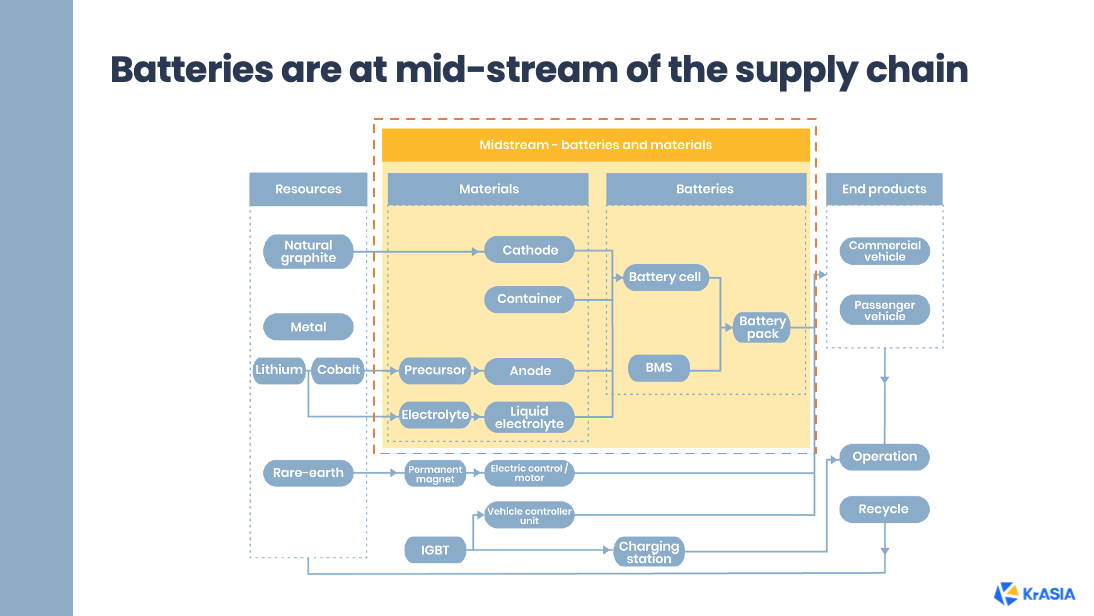KrASIA’s Morning Briefing is a closed-door presentation that delves into a different industry every 1st and 3rd Tuesday of the month. Register here for the next episode on FMCG in China, 20 April, 9 – 9.30am (GMT +8); the case study will be on Unilever and P&G’s largest domestic competitor in China’s home care sector.
Episode 4 of Morning Briefing delved into the EV battery industry, giving a quick overview of the scale of China’s EV battery industry, examine the technical challenges battery makers face and how that’s being managed both globally and in China. And of course, CATL was discussed during the case study segment.
Industry Overview
The team noted that in 2020, China ranked first in global EV battery market share, occupying 46.4%. Domestically, the industry has also seen continued growth in the last few years, going from 55.7 GWh in 2018 to 61.3 GWh in 2020. The supply chain is also well developed with battery manufacturing sitting squarely in the mid-stream.

Challenges and Solutions
Manufacturing batteries and constantly improving them is technically difficult and there are a few key aspects to consider. The team discussed these challenges are and how battery makers are responding to them. First, concerns around the procurement of raw materials. The biggest issue surrounding these raw materials, in particular cobalt, is the supply that is available and, of course, the price. With over 65% of global production of Cobalt concentrated in the Democratic Republic of Congo, the lack of transparency of the the supply chain and risks such as child labour exploitation create greater concern over Cobalt reserves.
Second, designing the battery poses more technical challenges. Engineers would have to balance three key aspects — fire safety, energy density and charging speeds, as well as battery lifespan. Third, waste and pollution stands a huge problem if recycling and re-utilization systems and technology do not mature alongside the promotion of EVs into the mainstream. Indonesia for example, has seen recent cases of nickel mining pollution affecting the livelihoods of villagers in Central Sulawesi. Read here for more on that.
In response to these universal challenges, the team introduced how battery makers manage them, with some solutions specific to China.
Constant R&D has allowed battery makers to come up with incremental steps in tackling issues surrounding battery safety and lifespan. CATL, for example, had produced a battery that would only emit smoke and not catch fire in the event of a battery problem. Data collected by Tesla also indicates that battery life is getting longer due to a combination of advanced battery management systems and temperature control liquid cooling systems. The holy grail solid-state batteries, whereby more stable solid electrolytes are used instead of flammable liquid ones, are also being developed by most leading battery players.

The Chinese market has also demonstrated a few solutions that have only been replicated at scale domestically. This includes the battery replacement and leasing model employed by local EV automakers. For example, NIO recently completed its 2 millionth battery swap at its battery stations, and intends to have 500 of these stations by the end of the year. Additionally, China has its own regulations in place for battery recycling and disposal.
Case study: Contemporary Amperex Technology Limited (CATL)
Moving into the case study section of the presentation, the team went through as quick overview and timeline of the company, the factors that have contributed to its current success, potential challenges, and finally cover the strategic investments that they’ve made.
CATL leads globally with 34GWh installed capacity, garnering a market share of 24.82%. Domestically, in Q1- Q3 2020 CATL’s brand, holds 47.57% market share. Listed on the Shenzhen stock exchange, CATL’s market cap peaked at the beginning of 2021, hitting a little over 143 billion USD.
Factors to its success include the effect of top-down national subsidies that encouraged demand for EVs and cut out foreign competition from 2011 – 2019. CATL’s varied experience with partners such as BMW and Honda allowed them to grow in different areas of expertise, such as its knowledge about different types of batteries based on clients’ specifications and R&D across the supply chain. This willingness to extend their range has honed their competitive edge. As such, CATL has been able to position itself as a solutions provider instead of just a manufacturer.

Despite all the positives, it is important to consider the pitfalls and challenges that CATL may face in the future. This includes global competition from other battery makers. For example, US battery maker QuantumSpace, which works closely with VW, announced late last year that it’s making progress in developing the fist commercially viable solid-state battery. Additionally, now that the domestic limitation on foreign battery makers has been phased out, foreign players are back on a more level playing field in China. Some automakers themselves have also expressed plans to develop their own batteries in the future.
Looking to the future, CATL is recognized within China as one of the battery makers that is most willing to invest in R&D, and go beyond battery related technology. CATL has made strategic investments all across the battery supply chain and in other areas of the mobility industry, such as gaining a 7.29% stake in Wuxi Lead Intelligence and a 20% stake in Finnish auto-manufacturer Valmet. Moreover, the company is actively building its European network through its USD 2 billion plant in Germany and investments in battery manufacturers and dealers, like Hoppecke and Quantron. This also includes business partnerships with European OEMs and other EV companies like Netherlands-based VDL.
With the vast roadmap that CATL has built for itself, energy storage and batteries are far from being its final act.
